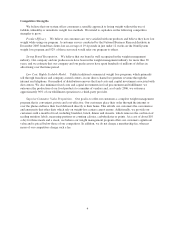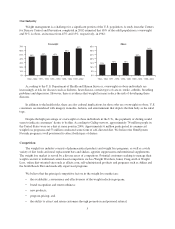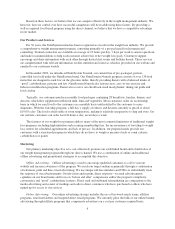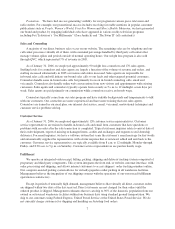Nutrisystem 2005 Annual Report Download - page 18
Download and view the complete annual report
Please find page 18 of the 2005 Nutrisystem annual report below. You can navigate through the pages in the report by either clicking on the pages listed below, or by using the keyword search tool below to find specific information within the annual report.• the loss of privacy with respect to personal weight and health information;
• delays in responses to inquiries;
• delivery time associated with online or telephone orders, compared to the immediate receipt of products
at a store or weight loss center;
• shipping charges, which do not apply to shopping at stores or traditional weight loss centers;
• the ability to return or exchange orders;
• the absence of face-to-face contact with counselors and other dieters; and
• the loss of the discipline, accountability and support associated with group sessions.
If these or other factors cause existing and potential customers not to accept our direct-to-consumer business
strategy, we will not be able to maintain our growth and our operating results will suffer.
Future acquisitions and the pursuit of new business opportunities present risks, and we may be unable to
achieve the financial and strategic goals of any acquisition or new business.
A component of our growth strategy is to acquire existing businesses or pursue other business opportunities
in the market for weight management and fitness products and services. Even if we succeed in acquiring or
building such businesses, we will face a number of risks and uncertainties, including:
• difficulties in integrating newly acquired or newly started businesses into existing operations, which
may result in increasing operating costs that would adversely affect our operating income and earnings;
• the risk that our current and planned facilities, information systems, personnel and controls will not be
adequate to support our future operations;
• diversion of management time and capital resources from our existing businesses, which could
adversely affect their performance and our operating results;
• dependence on key management personnel of acquired or newly started businesses and the risk that we
will be unable to integrate or retain such personnel;
• the risk that the new products or services we may introduce or begin offering, whether as a result of
internal expansion or business acquisitions, will not gain acceptance among consumers and existing
customers;
• the risk that new efforts may have a detrimental effect on our brand;
• the risk that we will face competition from established or larger competitors in the new markets we may
enter, which could adversely affect the financial performance of any businesses we might acquire or
start; and
• the risk that the anticipated benefits of any acquisition or of the commencement of any new business
may not be realized, in which event we will not be able to achieve any return on our investment in that
new business.
If we do not continue to receive referrals from existing customers, our customer acquisition cost may
increase.
We rely on word of mouth advertising for a portion of our new customers. If our brand suffers or the
number of customers acquired through referrals drops due to other circumstances, our costs associated with
acquiring new customers and generating revenue will increase, which will, in turn, have an adverse affect on our
profitability.
14
























